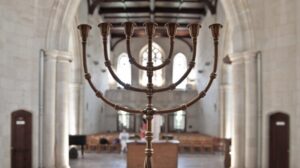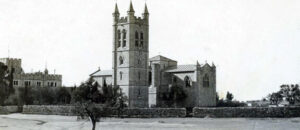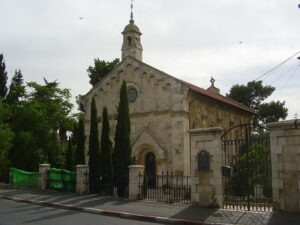The British in Jerusalem
“ The fanatical Mufti of Nablus is not a learned man, and is considered a plebeian parvenu among the old Arab families of that town; at the same time a really learned man is living there whose ancestors for several generations have been muftis of Nablus, and he is a good friend of the Protestants. I intend to recommend him to that office instead of the present man.”
James Finn’s private note about the Mufti of Nablus is a splendid specimen of 19th century Britain imperial hubris. Finn loved the cut and thrust of local politics. He became the British consul in Jerusalem in 1845, decided he knew who the next Mufti of Nablus should be in 1853, and brought on himself the removal from post in 1863. Nablus, a town in the north of, what is today, the West Bank, drew Finn’s attention because a Greek Orthodox mob had attacked the new Protestant school there. There was a rumour that Muslims had instigated the attack. ‘A good friend of the Protestants’ hides the complexity of Finn’s job. He had to protect British interests in a land where the means of protecting those interests were local religious politics. Problems arose though when those tasked with protecting British interests, like Finn, started thinking that their views on the local religious politics were more important than the priorities of their superiors in London.
The use of religion as a fig-leaf for British strategic interests is evident in Christ Church, a church inside the city walls, near Jaffa Gate, consecrated in 1849, and the first building that the British built in Jerusalem. The British government had to spend considerable political capital with the Ottoman government in order to build the first European church in Jerusalem. It did not do so in order just to provide a church for the two Protestant families in the city. The wali (governor) of Egypt, Muhammad Ali, had rebelled against the Ottoman government and seized Jerusalem and the rest of Greater Syria, in 1831. The status quo was under threat, including British control of the trade routes to India. France and Russia had a position to influence this new situation due to their respective protection of the Catholic community and the Russian Orthodox community in Jerusalem. Britain could not prop up the Ottoman government and seize territory from it at the same time. Therefore the solution was to acquire a similar kind of influence as Russia and France. There were no Protestants in Jerusalem though but the Jewish community provided a handy substitute. The purpose of Christ Church was to make a physical statement of Britain’s presence as protector of the Jews and the clearest indication is the fact that there was no cross in Christ Church but there was a menorah.
CHRIST CHURCH, JERUSALEM
British buildings in Jerusalem continue to be physical statements of British strategy working through religious influence. Samuel Gobat, the Anglican Bishop of Jerusalem, switched the form of that influence away from protecting and converting Jews to developing a Protestant community, based on converting local Orthodox Christians. The school he built on Mount Zion in 1855, one of the first buildings outside the walls of the Old City, was designed to convert local Christian children to Protestantism. Gobat consecrated St Paul’s Church in 1873 as a church for Arabic speaking Anglicans- a group that did not exist thirty years previously. In 1892 the building of an Anglican Cathedral. Kaiser Wilhem II of Germany had ordered the construction of the Church of the Redeemer on land he received from the Ottoman government in return for the Kaiser’s support. Jerusalem had become an extension of the great power game over trade. The Crimea War was triggered by Russian opposition to French demands over the maintenance of the holy places in Jerusalem. Building churches and schools had become a means of maintaining the influence in Jerusalem that could prevent France and Russia undermining the status quo, including that precious trade to India.
It is difficult though to believe that the buildings the British built in Jerusalem were just reverberations in the long history of powers redistributing the globe’s resources. Looking at them, there are too singular in style for them just to be mere outposts of Global Britain Inc. Christ Church is built in a Tudor ecclesiastical style, the bishop’s house, a residence for the director of the London Society for Promoting Christianity among the Jews, was erected in 1876 in an Ottoman style for private houses, the Ophthalmic Hospital was built in the 1880s in a style reminiscent of local houses, the Cathedral of St George in a neo-Gothic. There is no consistent style, nor an evident development of style across the decades, let alone a grand, imperial style announcing Britain’s arrival in Jerusalem.
ST GEORGE’S CATHEDRAL, JERUSALEM
Buildings built by the British in the 19th century certainly strengthened the interests of the British government in Jerusalem. Nevertheless the government did not finance or build many of the buildings and this is part of the reason for the lack of consistency in style. Missionary societies and other charitable organisations were erecting buildings according to their finances and their beliefs about the purpose of the building. The British government had initiated British activity in the city in the 1830s and 1840s, and it used religion as a means of acquiring influence. Quickly though the drivers of activity became the missionary societies and charitable organisations. These organisations set about turning the celestial, imaginary Jerusalem of their dreams into a reality. Many of them were early nineteenth century Evangelicals and the Jerusalem of their dreams was a city full of Jews being converted and ushering in the Last Days. They believed that Britain had a special role in history of returning the Jews to their God-given home. The British government had established itself as protector of the Jews in the Ottoman Empire and these organisations believed that the government meant it. Therefore the British government did not need to establish a colony in Jerusalem. The missionaries were establishing churches, schools and hospitals and so playing the game of politics in Jerusalem for the government.
ST PAUL’S CHURCH, JERUSALEM
James Finn’s career demonstrates that the British government did not though step back after the 1840s and allow the missionary societies to take over. ”It was uncommonly pleasant to visit a Jew among his own land in Judea” was his report on a visit to a Jewish vineyard. The use of “Judea”, rather than the more commonplace “Holy Land”, is striking. Finn was one of the first people to build outside the walls of the Old City. In 1853 he purchased Karm al-Khalil (Abraham’s Vineyard in Arabic, today known by its Hebrew name of Kerem Avraham), twenty minutes walk away from the Old City. There he built a farm in order to provide employment for Jews in the city. His belief in his own personal role in restoring the Jews to their “own land” caused him to become insolvent, spending a bit too much of his money on his pet projects. London could not afford to have a consul who was insolvent and to make matters worse Finn had alienated other agents of the British state in Jerusalem. Bishop Gobat tried to prevent Finn’s blatant religious proselytising in the city. It was one thing to claim to be the protector of the Jews, it was another to convert them to Anglicanism and then British citizens. London stepped in to remove Finn when he retaliated against Gobat and tried to prevent him leaving the city. British strategic interests still came before ideas, even for British consuls. The physical landscape of Jerusalem was changing as the British government’s intervention in the city stimulated religious and romantic dreams. British strategic interests were never far away though. When it became in Britain’s strategic interests to capture the city in 1917, a very different architectural legacy was left behind.









